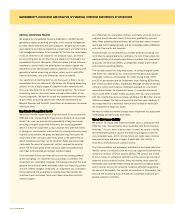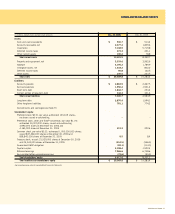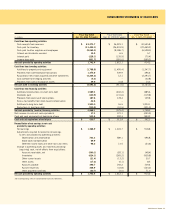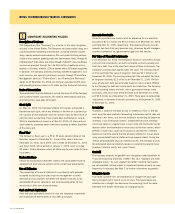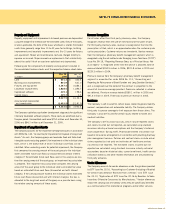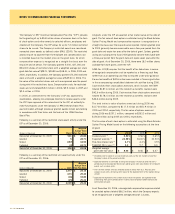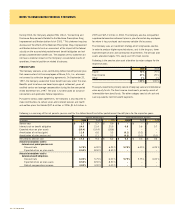CVS 2006 Annual Report Download - page 37
Download and view the complete annual report
Please find page 37 of the 2006 CVS annual report below. You can navigate through the pages in the report by either clicking on the pages listed below, or by using the keyword search tool below to find specific information within the annual report.
34 CVS Corporation
NOTES TO CONSOLIDATED FINANCIAL STATEMENTS
1 SIGNIFICANT ACCOUNTING POLICIES
Description of Business
CVS Corporation (the “Company”) is a leader in the retail drugstore
industry in the United States. The Company sells prescription drugs and
a wide assortment of general merchandise, including over-the-counter
drugs, beauty products and cosmetics, film and photo finishing services,
seasonal merchandise, greeting cards and convenience foods, through its
CVS/pharmacy® retail stores and online through CVS.com®. Also, healthcare
services are provided through the 146 MinuteClinic healthcare clinics,
located in 18 states, of which 129 are located within CVS retail drugstores.
In addition, the Company provides pharmacy benefit management, mail
order services and specialty pharmacy services through PharmaCare
Management Services (“PharmaCare”) and PharmaCare Pharmacy®
stores. As of December 30, 2006, the Company operated 6,202 retail
and specialty pharmacy stores in 43 states and the District of Columbia.
Basis of Presentation
The consolidated financial statements include the accounts of the Company
and its wholly-owned subsidiaries. All material intercompany balances
and transactions have been eliminated.
Stock Split
On May 12, 2005, the Company’s Board of Directors authorized a
two-for-one stock split, which was effected in the form of a dividend by
the issuance of one additional share of common stock for each share of
common stock outstanding. These shares were distributed on June 6,
2005 to shareholders of record as of May 23, 2005. All share and per
share amounts presented herein have been restated to reflect the effect
of the stock split.
Fiscal Year
The Company’s fiscal year is a 52 or 53 week period ending on the
Saturday nearest to December 31. Fiscal 2006, which ended on
December 30, 2006, fiscal 2005, which ended on December 31, 2005
and fiscal 2004, which ended on January 1, 2005, each included
52 weeks. Unless otherwise noted, all references to years relate to these
fiscal years.
Reclassifications
Certain reclassifications have been made to the consolidated financial
statements of prior years to conform to the current year presentation.
Use of Estimates
The preparation of financial statements in conformity with generally
accepted accounting principles requires management to make
estimates and assumptions that affect the reported amounts in the
consolidated financial statements and accompanying notes. Actual
results could differ from those estimates.
Cash and Cash Equivalents
Cash and cash equivalents consist of cash and temporary investments
with maturities of three months or less when purchased.
Accounts Receivable
Accounts receivable are stated net of an allowance for uncollectible
accounts of $73.4 million and $53.2 million as of December 30, 2006
and December 31, 2005, respectively. The balance primarily includes
amounts due from third party providers (e.g., pharmacy benefit managers,
insurance companies and governmental agencies) and vendors.
Fair Value of Financial Instruments
As of December 30, 2006, the Company’s financial instruments include
cash and cash equivalents, accounts receivable, accounts payable and
short-term debt. Due to the short-term nature of these instruments, the
Company’s carrying value approximates fair value. The carrying amount
and the estimated fair value of long-term debt was $3.1 billion as of
December 30, 2006. The carrying amount and the estimated fair value
of long-term debt was $1.9 billion as of December 31, 2005. The fair
value of long-term debt was estimated based on rates currently offered
to the Company for debt with similar terms and maturities. The Company
had outstanding letters of credit, which guaranteed foreign trade
purchases, with a fair value of $6.8 million as of December 30, 2006,
and $9.5 million as of December 31, 2005. There were no outstanding
investments in derivative financial instruments as of December 30, 2006
or December 31, 2005.
Inventories
Inventory is stated at the lower of cost or market on a first-in, first-out
basis using the retail method of accounting to determine cost of sales and
inventory in our stores, and the cost method of accounting to determine
inventory in our distribution centers. Independent physical inventory
counts are taken on a regular basis in each store and distribution center
location (other than two recently constructed distribution centers, which
perform a continuous cycle count process to validate the inventory
balance on hand) to ensure that the amounts reflected in the accompa-
nying consolidated financial statements are properly stated. During the
interim period between physical inventory counts, the Company accrues
for anticipated physical inventory losses on a location-by-location basis
based on historical results and current trends.
Goodwill
The Company accounts for goodwill and intangibles under Statement of
Financial Accounting Standards (“SFAS”) No. 142, “Goodwill and Other
Intangible Assets.” As such, goodwill and other indefinite-lived assets
are not amortized, but are subject to impairment reviews annually, or more
frequently if necessary. See Note 3 for further information on goodwill.
Intangible Assets
Purchased customer lists are amortized on a straight-line basis over
their estimated useful lives of up to 10 years. Purchased leases are
amortized on a straight-line basis over the remaining life of the lease.
See Note 3 for further information on intangible assets.


